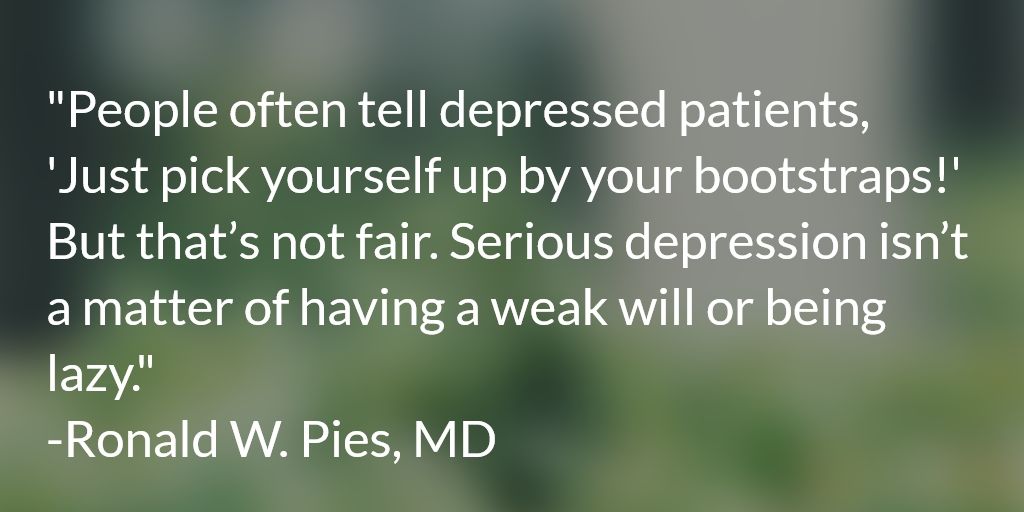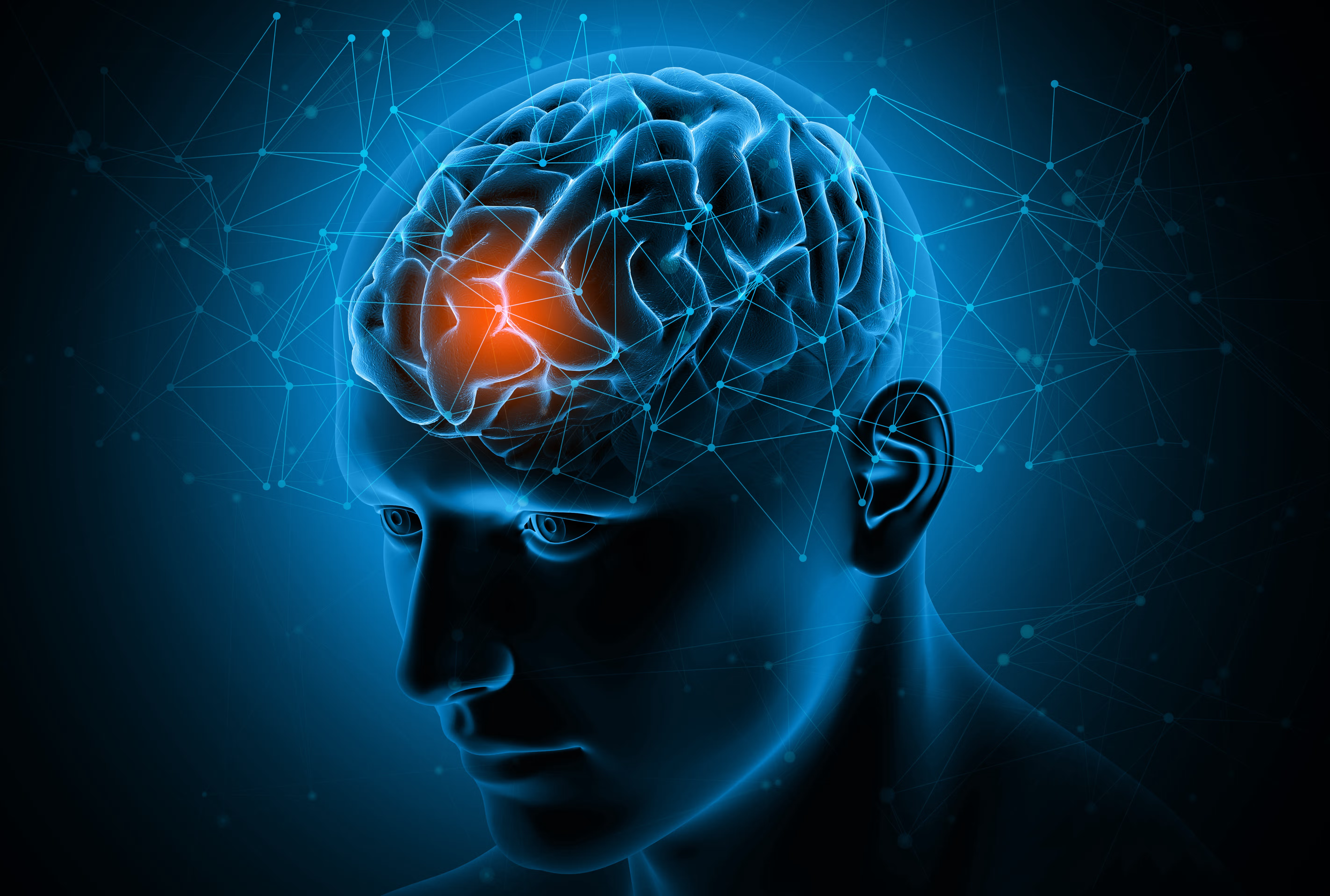Publication
Article
Psychiatric Times
Depression: A 5-Minute Seminar for Patients
Author(s):
We can teach patients a lot about the biopsychosocial causes of depression-even in 5 minutes.

©ClaudiaFernandes/ Shutterstock

COMMENTARY
Wouldn’t it be great if you could explain to your severely depressed patient exactly what causes major depression-in 5 seconds? For example, you might try one of these approaches:
1. Major depression is caused by a chemical imbalance in the brain
2. Major depression is caused by anger at others, turned inward against oneself
There-easy, right? The first “explanation,” of course, is a spinoff of the mythological “chemical imbalance theory of mental illness”-which was never a full-fledged theory propounded in the highest echelons of American psychiatry.1 The second statement is a psychoanalytic hypothesis that had some currency when I was in residency and for which there is some (mixed) empirical support.2 In my view, both “explanations” vastly oversimplify the complex causes of depression; indeed, they are both reductionistic. (Dr Glen Gabbard has pointed out that psychoanalytic interpretations may sometimes be as reductionistic as biological ones: ie, “Both [psychoanalysts] and their patients secretly are drawn to simple formulations that eschew complexity.”3)
But what if we abandon these 5-second oversimplifications and spend, roughly, 5 minutes with our depressed patients, explaining what we know (and don’t know) about the etiology of major depression? In my experience, such a 5-minute discussion can fit quite feasibly into a half-hour session. (Contrary to popular lore, the average psychiatric session is not a “15-minute med check”-it is probably closer to a 35-minute meeting.4). As a psychopharmacology consultant for over 25 years, I saw mostly patients with refractory mood disorders, usually referred by other psychiatrists.
What follows is an idealized dialogue-with annotations for the clinician-similar to the kind I would have when I first evaluated a seriously depressed patient. It makes use of 2 metaphors or visual images that I found very useful and that my patients seemed to appreciate-namely, the “funnel” and the “bridge.” I would often hand-draw these images and give the drawings to the patient, as a kind of transitional object–cum–educational device. Here’s roughly how the discussion would go with “Joe” (a composite patient), somewhat modified for teaching purposes.
CASE VIGNETTE
The patient is “Joe,” a 40-year-old construction supervisor, recovering from his second severe major depressive episode.
Joe: So, this lousy depression, Doc-what causes it? Is it some kind of chemical thing? Or is it just that I’m weak, or messed up, or what?
RP: Well, first, Joe, depression doesn’t mean you are “weak” or “messed up”! People often tell depressed patients, “Just pick yourself up by your bootstraps!” But that’s not fair. Serious depression isn’t a matter of having a weak will or being lazy. We don’t know the exact causes of depression, but there are probably many causes that interact.
Joe: Okay, like what? Bad parents? Bad diet?
RP: Well, most psychiatrists believe that depression has biological, psychological, and social causes. If we visualize these 3 factors coming together at the top of this funnel I’m drawing, then, at the bottom, we have depression as the outcome.
Joe: Okay, but-what do those terms really mean? Is it that chemical imbalance idea, or some Freudian thing? And what do you mean by “social”?
RP: It’s far too simple to speak of a “chemical imbalance,” Joe, and there are so many chemicals in the brain, it’s nearly impossible to know what the right “balance” is for any particular patient. That said, we have good evidence that in severe depression, the internal environment in the brain is often abnormal, compared with the brains of people who aren’t depressed.5
Joe: You lost me, Doc! What do you mean, “internal environment”?
RP: Well, Joe, you know that the brain is made up of billions of cells called neurons, right? We think that for many people with severe depression, the neurons in some parts of the brain may not be communicating properly with neurons in other brain regions-some brain “circuits” may be too active while others may not be active enough.6 That could be due to a problem with brain chemicals-neurotransmitters-released by the neurons, but it could also mean there’s a problem with the receptors for these chemicals-those little slots where the neurotransmitters land. The receptors might be too sensitive or not sensitive enough.
We also have evidence that growth of new brain cells and the little branches that connect them may be reduced in major depression.7 In children who suffer bouts of major depression, there may actually be a gradual loss of “gray matter”-basically, brain cells and their branching extensions.8 We don’t know exactly how antidepressants work, but they may boost brain cell growth and enhance the branching process.9
This takes some time, which may be why antidepressants take a few weeks to work. By the way, Joe, there are also lots of medical factors and conditions that can cause or worsen depression-such as low thyroid function, some vitamin deficiencies, various drugs, and so on. That’s why we checked your labs earlier.
Joe: So far, this is all biology. So if depression is biological, can people get it from their parents?
RP: It’s not like inheriting blue eyes or blond hair. But people probably do inherit the tendency toward depression. Your genes-the units of heredity-make proteins that are involved in thousands of biological processes. If your genes are not making the right proteins in your brain, that may increase your risk of depression.
With bipolar disorder-or manic- depressive illness-it’s pretty clear that there is a hereditary factor. For example, if one identical twin has bipolar disorder, the other has a 60% to 80% chance of developing it too.10 The hereditary piece isn’t as strong in other types of depression but . . .
Joe: Wait a minute, Doc! What about the other 20% to 40% in the bipolar twins? The ones who don’t inherit the depression? How do you explain that, if they’re identical twins?
RP: So here is where we get into the “psychological” and “social” pieces of the puzzle. Even identical twins may have different psychological habits. We don’t know for sure if self-defeating, “negative” thoughts cause episodes of major depression, or whether they are the effect of a depressive bout. But certainly, the way a person views the world can have a profound effect on mood.
For example, if someone turns you down for a date, and you tell yourself that you don’t deserve to be loved, or that you will never be loved, you will be setting yourself up for depressive feelings.11 If you constantly tell yourself that you must be perfect at everything you do, you are also setting yourself up for feeling depressed. Whether clinical depression will actually develop probably depends on your genetic makeup and how resilient you are in the face of setbacks and stress-how well you “roll with the punches.”12
To complicate things, depression itself can generate a “negative filter” so that everything looks gray and gloomy-which leads to more negative thoughts, in a kind of vicious circle. And then, of course, there are all the social experiences, good and bad, that happen to you from childhood on.
Joe: Like if you experience a trauma as a kid, or one of your parents dies? Can that cause depression?
RP: It’s always hard to know if one single thing “causes” a depressive bout. It is usually a combination of things, and it’s safer to call things “risk factors” rather than “causes.” Major stress early in life, such as child abuse or neglect, probably increases the risk of later depression.13 And there’s good evidence that parental separation-for example, when parents divorce-is a risk factor for depression.14
And just to round out the “social” component that goes into that funnel, there’s the issue of social support. Think about people with no friends or family to help them deal with the stresses and losses of life-it’s not surprising that a lack of social supports increases the risk of major depression.15
Joe: I get the “bio, psycho, social” thing, Doc. But I still have some trouble with the idea of taking the antidepressant. I mean, some of my friends-they say that I’m just using a crutch.
RP: Well, Joe, there’s nothing wrong with a crutch if you’ve got a broken leg! But let me give you a different image to keep in mind. As I see it, medication is like a bridge between feeling terrible and feeling better. But you still have to walk across that bridge.
Joe: Meaning, I’ve got to do the work in therapy, maybe change the way I see things, change my mental habits?
RP: That’s exactly right, Joe. And we have some evidence that medication and psychotherapy together work better or faster than one or the other alone and that each may work on different “pieces” of the depression.16 In my experience, medication is usually more helpful with low energy, poor concentration, poor appetite, and insomnia. Psychotherapy often helps more with low self-esteem, excessive guilt, or distorted ways of thinking.17 Almost always, I advise a combination of medication and therapy for severe major depression.
Conclusion
This sort of dialogue may not work for you in your practice, but some version of it might. Bumper sticker pseudo-explanations-whether biological or psychological-are a disservice to our patients, who deserve a basic discussion of causes and risk factors in major depression and other psychiatric illnesses. The good news is that, for many patients, the initial discussion needn’t take more than 5 minutes.18
For further reading
Pies RW. Antidepressants: conundrums and complexities of efficacy studies. J Clin Psychopharmacol. 2016;36:1-4.
This article was originally published on January 19, 2016 and has since been updated.
Disclosures:
Dr Pies is Professor in the psychiatry departments of SUNY Upstate Medical University, Syracuse, New York, and Tufts University School of Medicine, Boston. He is Editor in Chief Emeritus of Psychiatric Times. He reports no conflicts of interest concerning the subject matter of this article.
References:
Notes and references
1. See, eg, the 1978 statement by the Board of Trustees of the American Psychiatric Association: “Psychiatric disorders result from the complex interaction of physical, psychological, and social factors and treatment may be directed toward any or all three of these areas.” American Psychiatric Association. Position statement on active treatment. Am J Psychiatry. 1979;136:753. http://www.psychiatry.org/File%20Library/Learn/Archives/Position-1978-Active-Treatment.pdf. Accessed February 5, 2016. Neither DSM-III (1980) nor DSM-IV (1994) asserted anything remotely resembling a “chemical imbalance theory” of mental disorders; DSM-IV stated flatly, “. . . a diagnosis does not carry any necessary implications regarding the causes of the individual’s mental disorder or its associated impairments” (p. xxiii).
2. In his 1917 paper, Mourning and Melancholia, Freud advanced the hypothesis that depression (melancholia) arose following the loss of an ambivalently loved object, with anger subsequently directed against the internalized representation (introject) of the lost person. According to Prof. Roger P. Greenberg, PhD (co-author, with Prof. Seymour Fisher, of Freud Scientifically Reappraised [New York: Wiley; 1995]), about 44% of self-report studies support Freud’s hypothesis; whereas 24% contradict it and 32% are indeterminate. However, perceptual, projective, and/or behavioral measures support the anger turned inward idea in 72% of cases. Dr Greenberg concludes, “Overall . . . the evidence spanning several methodologies is reasonably supportive of Freud” (R. P. Greenberg, personal communication, January 2016).
3. Gabbard GO. “Bound in a nutshell”: thoughts on complexity, reductionism, and “infinite space.” Int J Psychoanal. 2007;88:559-574.
4. (M. Olfson, personal communication, January 2016.) Dr Olfson has done extensive research on the provision of psychotherapy by psychiatrists; see, eg, Mojtabai R, Olfson M. National trends in psychotherapy by office-based psychiatrists. Arch Gen Psychiatry. 2008;65:962-970.
5. A good general reference is the article “What causes depression?” http://www.health.harvard.edu/mind-and-mood/what-causes-depression. Accessed February 5, 2016. (Harvard Health Publications in collaboration with Michael Craig Miller, MD). For a technical discussion of major depression subtypes and their relationship to stress, see Gold PW, Machado-Vieira R, Pavlatou M. Clinical and biochemical manifestations of depression: relation to the neurobiology of stress. Neural Plast. 2015; 2015:581976. The authors note, “Stress precipitates major depression and influences its severity, duration, and natural history.”
6. Greicius MD, Flores BH, Menon V, et al. Resting-state functional connectivity in major depression: abnormally increased contributions from subgenual cingulate cortex and thalamus. Biol Psychiatry. 2007;62:429-437. The authors describe functional MRI studies that point to both over- and under-activity in specific limbic-cortical circuits, associated respectively with abnormal emotional and cognitive processes.
7. GaÅecki P, Talarowska M, Anderson G, et al. Mechanisms underlying neurocognitive dysfunctions in recurrent major depression. Med Sci Monit. 2015; 21:1535-1547. The authors argue that the biological underpinnings of depression have substantial overlap with those of neurodegenerative conditions, including reduced neurogenesis, increased apoptosis (programmed cell death), and immune-inflammatory processes.
8.Luby JL, Belden AC, Jackson JJ, et al. Early childhood depression and alterations in the trajectory of gray matter maturation in middle childhood and early adolescence. JAMA Psychiatry. 2016;73:31-38.
9. Masi G, Brovedani P. The hippocampus, neurotrophic factors and depression: possible implications for the pharmacotherapy of depression. CNS Drugs. 2011;25:913-931. The authors note, “. . . Antidepressant treatment increases BDNF levels, stimulates neurogenesis and reverses the inhibitory effects of stress, but this effect is evident only after 3-4 weeks of administration. . . .”
10. What causes depression? http://www.health.harvard.edu/mind-and-mood/what-causes-depression. Accessed February 5, 2016. For a thorough analysis of the genetics of bipolar disorder, see Smoller JW, Finn CT. Family, twin, and adoption studies of bipolar disorder. Am J Med Genet C Semin Med Genet. 2003;123C:48-58.
11. For the classic presentation of cognitive issues in depression, see A Guide to Rational Living, by Albert Ellis, PhD, and Robert A. Harper, PhD (Chatsworth, CA: Wilshire Books; 1975). Many studies of cognitive therapies show them to be effective in major depression, though whether “irrational” or “self-defeating” cognitions are causes or effects of depression-or both-is an area of some disagreement. Moreover, there is evidence that pharmacotherapy alone can reduce “dysfunctional attitudes” in major depression (Fava M, Bless E, Otto MW, et al. Dysfunctional attitudes in major depression. Changes with pharmacotherapy. J Nerv Ment Dis. 1994;182:45-49). Also, studies of psychotherapy efficacy are inherently complicated by the inability to “blind” subjects to the nature of the treatment: ie, cognitive-behavioral therapy trials cannot be double-blind. (See Douglas Berger MD, PhD. Double-blinding and bias in medication and cognitive-behavioral therapy trials for major depressive disorder. F1000Research. 2016;4:638. http://www.japanpsychiatrist.com/Abstracts/Blinding_Bias.pdf. Accessed February 5, 2016.)
12. Elisei S, Sciarma T, Verdolini N, Anastasi S. Resilience and depressive disorders. Psychiatr Danub. 2013;25(suppl 2):S263-S267. The authors note, “The term resilience has been borrowed from physics where it is used to describe the ability of a material to withstand impact without cracking.” They cite evidence showing that “. . . Resilience has proven to be a protective factor against the development of psychiatric disorders such as depression.”
13. Seok JH, Lee KU, Kim W. Impact of early-life stress and resilience on patients with major depressive disorder. Yonsei Med J. 2012;53:1093-1098. The authors cite evidence that early life stressors, such as inter-parental violence, physical abuse, and emotional abuse, might be a risk factor for depression.
14. Kendler KS, Neale MC, Kessler RC, et al. Childhood parental loss and adult psychopathology in women. A twin study perspective. Arch Gen Psychiatry. 1992;49:109-116. This study found that an increased risk of major depression and generalized anxiety disorder was associated with parental separation but not parental death.
15. Aneshensel CS, Stone JD. Stress and depression: a test of the buffering model of social support. Arch Gen Psychiatry. 1982;39:1392-1396. This study concluded that a “lack of social support contributes to the creation of depressive symptoms.” Of course, significant depression may itself be a cause of social alienation, so the potential for a vicious circle of cause and effect must be considered.
16. Cuijpers P, Sijbrandij M, Koole SL, et al. Adding psychotherapy to antidepressant medication in depression and anxiety disorders: a meta-analysis. World Psychiatry. 2014;13:56-67. This study found that combined treatment appears to be more effective than treatment with antidepressant medication alone in major depression. A review of 62 pivotal antidepressant trials (N = 13,802) and 115 published trials of psychotherapies concluded that in “the blinded trials, the combination of antidepressants and psychotherapy provided a slight advantage over antidepressants (p = 0.027) and psychotherapy (p = 0.022) alone.” (Khan A, Faucett J, Lichtenberg P, et al. A systematic review of comparative efficacy of treatments and controls for depression. PLoS One. 2012;7:e41778.)
17. These personal observations are somewhat supported by an early randomized, controlled study that compared the combination of amitriptyline and short-term interpersonal psychotherapy, either treatment alone, and a nonscheduled treatment control group in ambulatory acute, nonbipolar, nonpsychotic depressives. (DiMascio A, Weissman MM, Prusoff BA, et al. Differential symptom reduction by drugs and psychotherapy in acute depression. Arch Gen Psychiatry. 1979;36:1450-1456.) The study found that amitriptyline had its effect mainly on “vegetative” symptoms, such as sleep and appetite disturbance, often early in treatment. Psychotherapy had its effect mainly on mood, suicidal ideation, work, and interests, usually after 4 to 8 weeks. Recently, however, Roiser and colleagues-in an elegantly synoptic paper-argue that “. . . both antidepressant drugs and psychological therapies modify negative [information processing] biases, providing a common mechanism for understanding treatments for depression.” (Roiser JP, Elliott R, Sahakian BJ. Cognitive mechanisms of treatment in depression. Neuropsychopharmacology. 2012;37: 117-136.)
18. The 5-minute approach is presented here as an alternative to a less thorough or simplistic explanation, such as attributing the patient’s depression to a “chemical imbalance.” It is not meant to replace longer, more sophisticated discussions that some patients may request or require, sometimes in an ongoing discussion over several sessions. And, of course, informed consent to treatment entails an ongoing discussion of risks and benefits.






